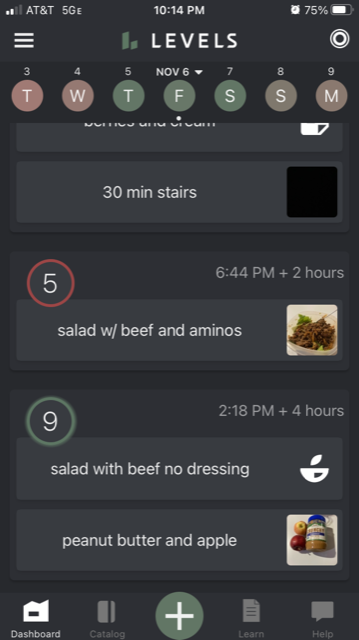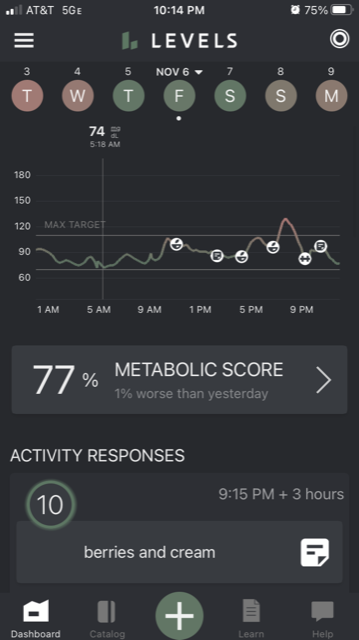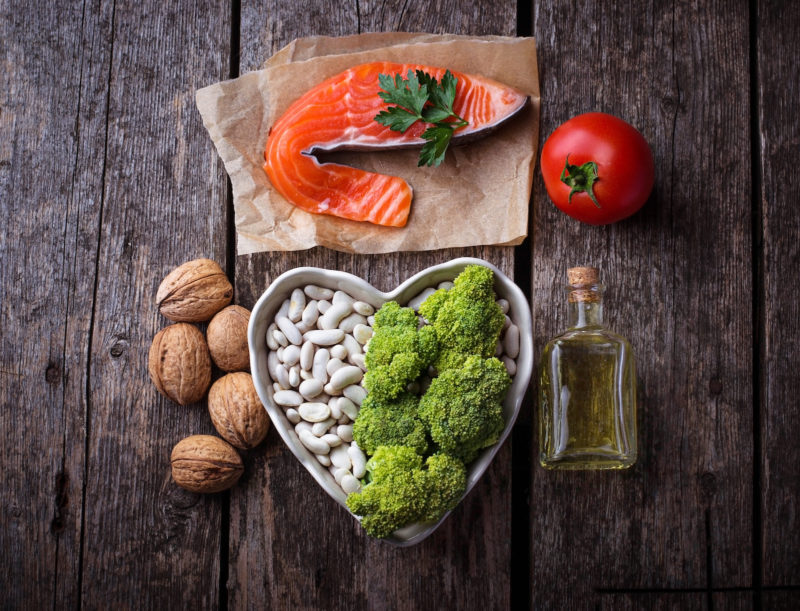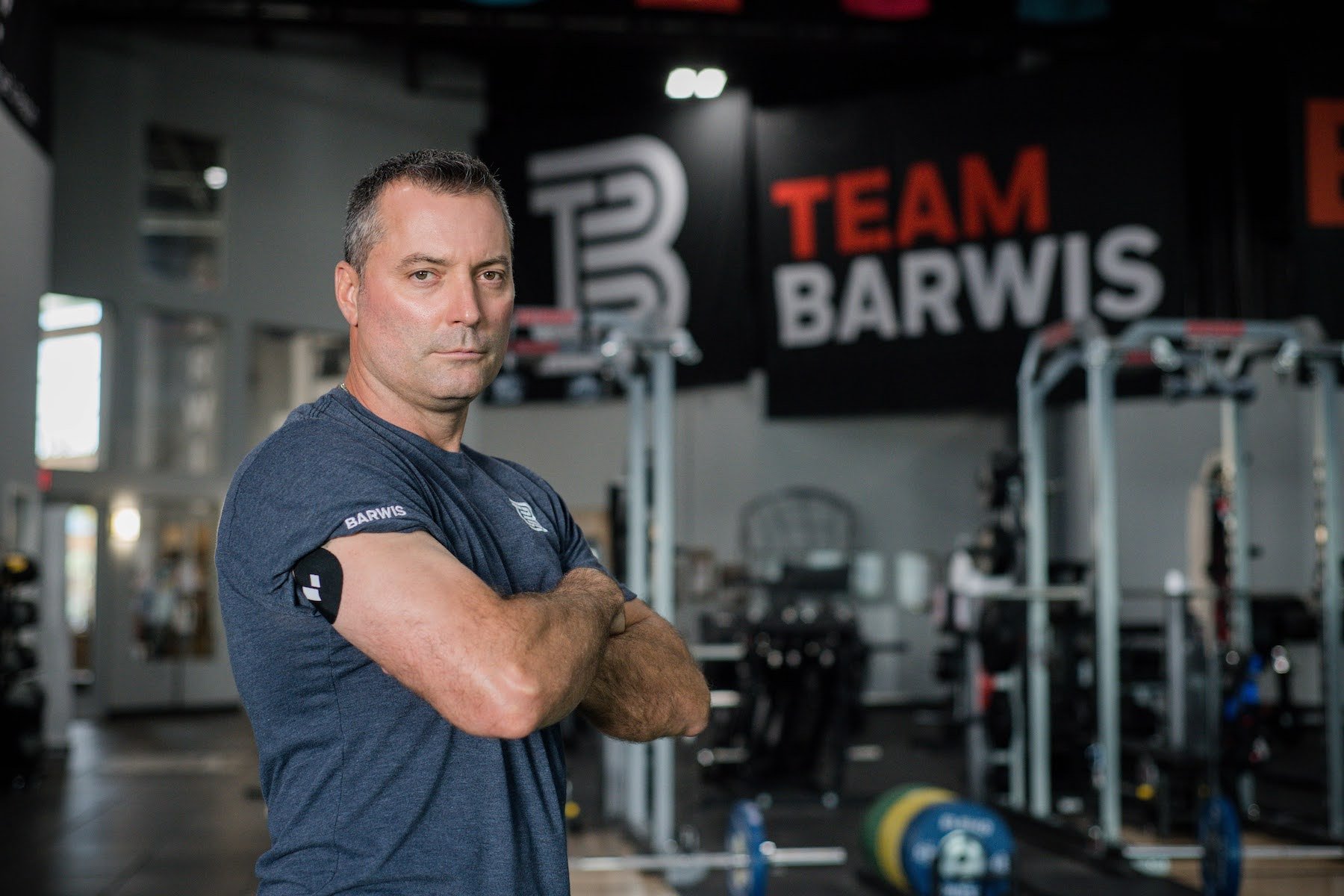Scott Hanson, 65, doesn’t go at projects half-speed. An aerospace quality-control inspector, he recently changed jobs to work less but still regularly puts in 50-hour weeks (we talked to him on a Sunday, his one day off). Likewise, his wife Jane also goes deep, regularly reading medical research articles and using her own prescription CGM and spreadsheet to track her health.
So when Scott visited his doctor last October and got back high cholesterol and blood-sugar lab numbers, after years of working to bring them down, the couple dove headfirst into a new regimen.
“The poor numbers I got in October were better than the very poor numbers I had gotten before,” Scott says. “So we were on the climb, but the hill was still very steep. And that’s where Levels fell in our lap.”
Jane knew the value of a CGM—but also how much work she put into managing her data. Also, Scott couldn’t get a prescription. Then she heard about Levels through Tiny Habits and signed up Scott right away.
Of course, the couple approached the project methodically, using the first few weeks to experiment. They found apples sent his glucose level soaring, while raspberries with a half cup of cream kept it steady. Coconut aminos, often advertised as a healthy alternative to soy sauce, turned out to be another no-no.
“You can’t generalize about what’s going to affect your blood sugar. It’s an individual thing. We’ll buy Product X, and it doesn’t do a hooting thing to my wife’s glucose. I eat a tablespoon of it, and I’m up to 150 mg/dl.”
“His first week was not good readings,” Jane says. “But he was eating beef and vegetables. No carbs! I finally said, ‘What are you putting on your stuff?’ And he said, ‘Coconut aminos.’ So we tested with some soup. Put in the coconut aminos, and it was an instant 20-point shift. It would have taken us forever to figure that out.”
 When Scott returned to his doctor in December, two months into the all-out effort, he and Jane were shocked at how much improvement he’d made: Scott’s fasting plasma glucose was now 83 mg/dL—solidly in the healthy range—after being stuck near prediabetic at around 100–105 mg/dL for years. Similarly, his A1C had been borderline prediabetes for years and now fell to 5.6%, just inside of normal.
When Scott returned to his doctor in December, two months into the all-out effort, he and Jane were shocked at how much improvement he’d made: Scott’s fasting plasma glucose was now 83 mg/dL—solidly in the healthy range—after being stuck near prediabetic at around 100–105 mg/dL for years. Similarly, his A1C had been borderline prediabetes for years and now fell to 5.6%, just inside of normal.
Even more unexpected were the huge improvements in his cholesterol numbers as an effect of the diet changes Levels inspired: Triglycerides and VLDLs both down 50%, from dangerously high to well inside normal. As Jane wrote in an email to us, “Huge big dancing parties! Never thought we would see this.”
Scott and Jane shared more about his journey.
On realizing he needed to improve his health:
Jane: About 10 years ago, suddenly his regular physical labs came up higher. Higher cholesterol, especially. Then higher fasting glucose about five years ago. So we’ve been working on diet changes for years, and he’s been pretty good about sticking to it, especially at home. At work, there’s junk all the time. People like him, so they bring him treats.
Scott: People are always leaving wonderful things on my desk. Now, I have to wait until they’re not there and throw them away.
Jane: He wasn’t overweight, he was exercising, he was trying to eat right. But he couldn’t break through this barrier of about 105 mg/dL for his fasting glucose. He still was at that prediabetic level.
Scott: Then I went to my doctor in October, and the numbers from the blood test were not attractive. And so we agreed that we would go for a 90-day head-down charge with a completely different set of disciplines. Scott was going to reach into his bag of good habits and pull out a rabbit. And that’s what we did.
I’m past 65 now. It was time to get down to brass tacks about my future if I wanted to have a decent retirement.
On finding the foods that worked for him:
Scott: You can’t generalize about what’s going to affect your blood sugar. It’s an individual thing. We’ll buy Product X, and it doesn’t do a hooting thing to her glucose. I eat a tablespoon of it, and I’m up to 150 mg/dl.
So when you share your meals with another person, you have to find common ground on what’s in the pantry. And if it’s bad for one of you, get rid of it. Or get real disciplined about not touching it.
We also appreciated that the CGM can show you what affects you when you least expect it. For example, that hamburger you typically have with no spike—put ketchup on it, and your numbers go through the roof. 
On why Levels helped him make changes that stick:
Scott: The proof in the pudding, period. You want to know what’s going to happen, watch the graph. And the fact that you can marry real-time changes in your blood glucose with exactly what you ate and when—it’s invaluable.
You sinned on Tuesday, but look at what you did on Wednesday and Thursday. That half a bagel that you ate on Tuesday is off the list now, and the numbers show it.
Jane: Two big things for him are, one, he knows he can’t cheat. The other is that he’s the kind of person who says, “I want the proof right in front of me.” This program has given him that.
Scott: So we got the evidence we needed. Our list of offending items is clear, and we saw that a diet without those items was positive, so we cast it in stone. That’s how it is.
On the benefits of getting his metabolic health under control:
Scott: I just feel a hell of a lot better. I’m just calmer. My body’s quiet. Not all the time; I still get stressed, but it’s different now. And at 65, that matters.
The effect has been drastic. My job requires me to go one-on-one with people through very technical topics. And my attention span is much sharper. I’m more focused. I hear more, I see more. I’m present. And that’s because the sugars are gone. So I’m poised well for the future.









